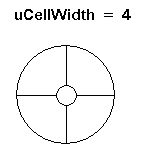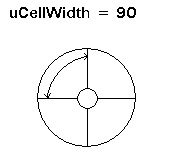Run the PixelateCommand on an image. by dividing it into circular cells with angle length = 5, and radius = 10.
 Copy Code
Copy Code
Imports Leadtools
Imports Leadtools.Codecs
Imports Leadtools.ImageProcessing.SpecialEffects
<TestMethod()> _
Public Sub PixelateConstructorExample()
Dim codecs As New RasterCodecs()
codecs.ThrowExceptionsOnInvalidImages = True
Dim leadImage As RasterImage = codecs.Load(Path.Combine(LEAD_VARS.ImagesDir, "sample5.cmp"))
' Prepare the command
Dim command As PixelateCommand = New PixelateCommand(5, 10, 100, New LeadPoint(CType((leadImage.Width \ 2), Integer), CType((leadImage.Height \ 2), Integer)), PixelateCommandFlags.Radial Or PixelateCommandFlags.WidthPeriod Or _
PixelateCommandFlags.HeightPeriod Or PixelateCommandFlags.Average)
command.Run(leadImage)
codecs.Save(leadImage, Path.Combine(LEAD_VARS.ImagesDir, "Result.jpg"), RasterImageFormat.Jpeg, 24)
End Sub
Public NotInheritable Class LEAD_VARS
Public Const ImagesDir As String = "C:\Users\Public\Documents\LEADTOOLS Images"
End Class
using Leadtools;
using Leadtools.Codecs;
using Leadtools.ImageProcessing.SpecialEffects;
[TestMethod]
public void PixelateConstructorExample()
{
// Load an image
RasterCodecs codecs = new RasterCodecs();
codecs.ThrowExceptionsOnInvalidImages = true;
RasterImage image = codecs.Load(Path.Combine(LEAD_VARS.ImagesDir, "sample5.cmp"));
// Prepare the command
PixelateCommand command = new PixelateCommand(5, 10, 100, new LeadPoint((image.Width / 2), (image.Height / 2)), PixelateCommandFlags.Radial | PixelateCommandFlags.WidthPeriod | PixelateCommandFlags.HeightPeriod | PixelateCommandFlags.Average);
command.Run(image);
codecs.Save(image, Path.Combine(LEAD_VARS.ImagesDir, "Result.jpg"), RasterImageFormat.Jpeg, 24);
}
static class LEAD_VARS
{
public const string ImagesDir = @"C:\Users\Public\Documents\LEADTOOLS Images";
}
using Leadtools;
using Leadtools.Codecs;
using Leadtools.ImageProcessing.SpecialEffects;
[TestMethod]
public async Task PixelateConstructorExample()
{
// Load an image
RasterCodecs codecs = new RasterCodecs();
codecs.ThrowExceptionsOnInvalidImages = true;
string srcFileName = @"Assets\Image1.cmp";
StorageFile loadFile = await Tools.AppInstallFolder.GetFileAsync(srcFileName);
RasterImage image = await codecs.LoadAsync(LeadStreamFactory.Create(loadFile));
// Prepare the command
PixelateCommand command = new PixelateCommand(5, 10, 100, LeadPointHelper.Create((image.Width / 2), (image.Height / 2)), PixelateCommandFlags.Radial | PixelateCommandFlags.WidthPeriod | PixelateCommandFlags.HeightPeriod |
PixelateCommandFlags.Average);
command.Run(image);
string destFileName = @"result.bmp";
StorageFile saveFile = await Tools.AppLocalFolder.CreateFileAsync(destFileName);
await codecs.SaveAsync(image, LeadStreamFactory.Create(saveFile), RasterImageFormat.Bmp, 24);
}





 Copy Code
Copy Code